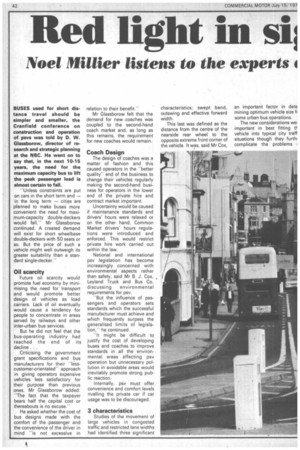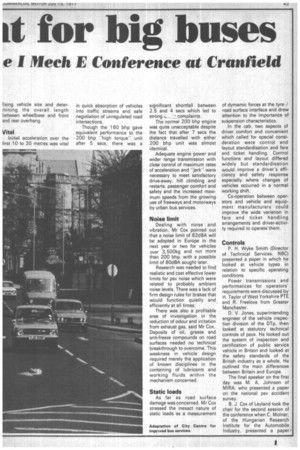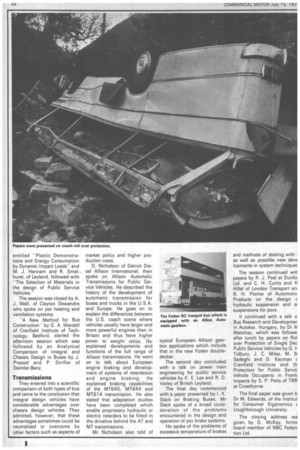Red light in sii
Page 44

Page 45

Page 46

If you've noticed an error in this article please click here to report it so we can fix it.
it for big buses
Noel Milner listens to the experts e I Mech E Conference at Cran field
BUSES used for short distance travel should be simpler and smaller, the Cranfield conference on construction and operation of pays was told by D. W. Glassborow, director of research and strategic planning at the NBC. He went on to say that, in the next 10-15 years, the need for the maximum capacity bus to lift the peak passenger load is almost certain to fall.
"Unless constraints are put on cars in the short term and —
in the long term cities are planned to make buses more convenient the need for maximum-capacity double-deckers would fall,Mr Glassborow continued. A created demand will exist for short wheelbase double-deckers with 50 seats or so. But the price of such a vehicle might well outweigh its .greater suitability than a standard single-decker.
Oil scarcity
Future oil scarcity would promote fuel economy by minimising the need for transport and would promote better design of vehicles as load carriers. Lack of oil eventually would cause a tendency for people to concentrate in areas served by railways and other inter-urban bus services.
But he did not feel that the bus-operating industry had reached the end of its decline .
Criticising the government grant specifications and bus manufacturers for their "lesscustomer-orientated'' approach in giving operators expensive vehicles less satisfactory for their purpose than previous ones, Mr Glassborow added: "The fact that the taxpayer bears half the capital cost or thereabouts is no excuse."
He asked whether the cost of bus designs made with the comfort of the passenger and the convenience of the driver in mind -is not excessive in
relation to their benefit."
Mr Glassborow felt that the demand for new .coaches was coupled to the second-hand coach market and, as long as this remains, the requirement for new coaches would remain.
Coach Design The design of coaches was a matter of fashion and this caused operators in the -better quality" end of the business to change their vehicles regularly making the second-hand business for operators in the lower end of the private hire and contract market important.
Uncertainty would be caused if maintenance standards and drivers' hours were relaxed or on the other hand, Common Market drivers' hours regulations were introduced and enforced. This would restrict private hire work carried out within the law.
National and international psv legislation has become increasingly concerned with environmental aspects rather than safety, said Mr B. J. Cox, Leyland Truck and Bus Co, discussing environmental requirements for psv.
-But the influence of passengers and operators sets standards which the successful manufacturer must achieve and which frequently surpass the generalised limits of legislation," he continued.
"it might be difficult to justify the cost of developing buses and coaches to improve standards in all the environmental areas affecting psv operation but unnecessary pollution in avoidable areas would inevitably promote strong public reaction.
Internally, psv must offer convenience and comfort levels rivalling the private car if car usage was to be discouraged.
3 characteristics
Studies of the movement of large vehicles in congested traffic and restricted lane widths had identified three significant characteristics; swept band, outswing and effective forward width.
This last was defined as the distance from the centre of the nearside rear wheel to the opposite extreme front corner of the vehicle. It was, said Mr Cox, an important factor in dete mining optimum vehicle size fi some urban bus operations.
The new considerations wei important in best fitting th vehicle into typical city traff situations though they furthi complicate the problems fixing vehicle size and determining the overall length between wheelbase and front and rear overhang_
Vital
Initial acceleration over the first 10 to 20 metres was vital in quick absorption of vehicles into traffic streams and safe negotiation of unregulated road intersections.
Though the 160 bhp gave equivalent performance to the 200 bhp "high torque" unit after 5 secs, there was a significant shortfall between 2.5 and 4 secs which led to strong _ complaints.
The normal 200 bhp engine was quite unacceptable despite the fact that after 7 secs the distance travelled with either 200 bhp unit was almost identical.
Adequate engine power and wider range transmission with close control of maximum rates of acceleration and "jerk" were necessary to meet satisfactory drive-away, hill climbing and restarts, passenger comfort and safety and the increased maximum speeds from the growing use of freeways and motorways by urban bus services.
Noise limit
Dealing with noise and vibration, Mr Cox pointed out that a noise limit of 82dBA will be adopted in Europe in the next year or two for vehicles over 3,500kg and not more than 200 bhp, with a possible limit of 80dBA sought later.
Research was needed to find realistic and cost effective lower limits for psv noise which were related to probably ambient noise levels. There was a lack of firm design rules for brakes that would function quietly and, efficiently at all times.
There was also a profitable area of investigation in the reduction of odour and irritation from exhaust gas, said Mr Cox. Deposits of oil, grease and anti-freeze compounds on road surfaces needed no technical breakthrough to overcome. This weakness in vehicle design required merely the application of known disciplines in the containing of lubricants and working fluids within the mechanism concerned.
Static loads
As far as road surface damage was concerned, Mr Cox stressed the inexact nature of static loads as a measurement of dymamic forces at the tyre / road surface interface and drew attention to the importance of suspension characteristics.
In the cab, two aspects of driver comfort and convenient which called for special consideration were control and layout standardisation and fare and ticket handling. Control functions and layout differed widely but standardisation would improve a driver's efficiency and safety response especially where changes of vehicles occurred in a normal working shift.
Co-operation between operators and vehicle and equipment manufacturers could improve the wide variation in fare and ticket handling arrangements and driver-activity required to operate them.
Controls
P. H. Wyke Smith (Director of Technical Services, NBC) presented a paper in which he looked at vehicle types in relation to specific operating conditions.
Power transmissions and performances for operators' requirements were discussed by H. Taylor of West Yorkshire PTE and R. Freelove from Greater Manchester.
D. V. Jones, superintending engineer of the vehicle inspection division of the DTp, then looked at statutory technical controls of psvs. He looked out the system of inspection and certification of public service vehicle in Britain and looked at the safety standards of the British industry as a whole. He outlined the main differences between Britain and Europe.
The final speaker on the first day was M. A. Johnson of MIRA, who presented a paper on the national psv accident survey, B. J. Cox of Leyland took the chair for the second session of the conference when C. Molnar, of the Hungarian Research Institute for the Automobile Industry, presented a paper entitled "Plastic Demonstrations and Energy Consumption by Dynamic Impact Loads" and M. J. Hannam and R. Smel-. hurst, of Leyland, followed with "The Selection of Materials in the design of Public Service Vehicles."
The session was closed by A. J. Wall, of Clayton Dewandre who spoke on psv heating and ventilation systems.
"A New Method for Bus Construction" by G. A. Wardell of Cranfield Institute of Technology, Bedford, started the afternoon session which was followed by an Analytical Comparison of Integral and Chassis Design in Buses by J. Pressel and P. Strifler of Daimler-Benz.
Transmissions
They entered into a scientific comparison of both types of bus and came to the conclusion that integral design vehicles have considerable advantages over -chassis design vehicles. They admitted, however, that these advantages sometimes could be neutralized or overcome by other factors such as aspects of market policy and higher production costs.
D. Nicholson of Detroit Diesel Allison International, then spoke on Allison Automatic Transmissions for Public Service Vehicles. He described the history of the development of automatic transmission for buses and trucks in the U.S.A. and Europe. He goes on to explain the differences between the U.S. coach scene where vehicles usually have larger and more powerful engines than in Britain and thus have .higher power to weight ratios. f-fe. explained developments and functions of the full range of Allison transmissions. He went on to talk about European engine braking and development of systems of retardation and engine braking. He explained braking capabilities of the MT640, MT644 and MT614 transmission. He also stated that adaptation studies have been completed which enable proprietary hydraulic or electric retarders to be fitted in the driveline behind the AT and MT transmissions.
Mr Nicholson also told of typical European Allison gearbox applications which include that in the new Foden doubledecker.
The second day concluded with a talk on power train engineering for public service vehicles by K. E. Lee and R. D. Varley of British Leyland.
The final day commenced with a paper presented by I. K. Slack on Braking Buses, Mr Slack spoke of a broad consideration of the problems encountered in the design and operation of psv brake systems.
He spoke of the problems of excessive temperature of brakes and methods of dealing with as well as possible new devE lopments in system techniques The session continued witl papers by R. J. Peel at Dunloi Ltd. and C. H. Curtis and H HiIlel of London Transport an' R. H. Pitcher of Automotiv Products on the design c hydraulic suspension and ai suspensions for psvs.
It continued with a talk o Bus Research and Developmer in Autokar, Hungary, by Dr IV Matolcsy, which was followe after lunch by papers on Rol over Protection of Single Dec Public Service Vehicles by G. Tidbury, J. C. Miles, M. IV Sadeghi and D. Kecman c Cranfield Institute and th Protection for Public Servic Vehicle Occupants in FrontE Impacts by S. P. Pelts of TRR at Crowthorne.
The final paper was given b Dr M. Edwards, of the Institut for Consumer Ergonomics E Loughborough University.
The closing address wa given by G. McKay, formE board member of NBC FederE tion Ltd.




























































































